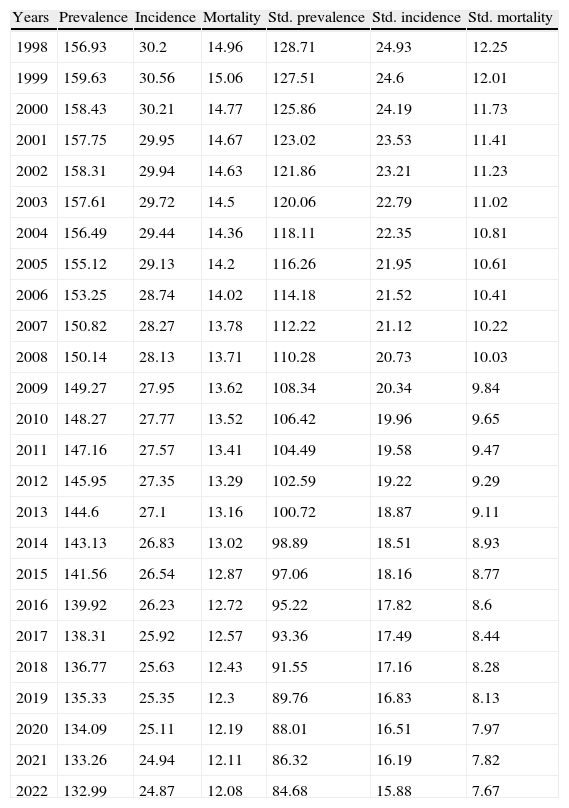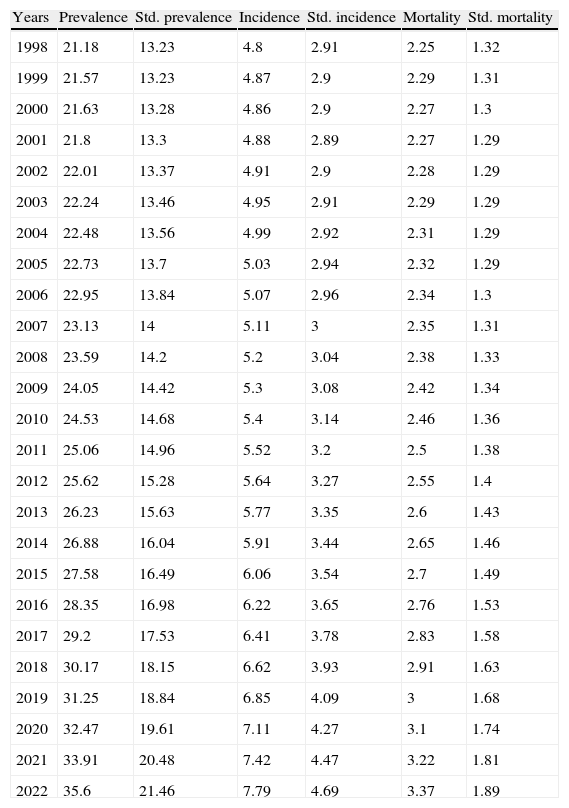One of the most frequent cancers in the world is bladder cancer that affects, according to some authors, 5.4 million persons in the most developed countries. Our study has aimed to estimate the impact projections of this disease in Spain between 2007 and 2022.
Material and methodsMortality data for bladder cancer mortality was used International Classification of Diseases 10th revision (ICD-10 C67), and the population data from 1998 to 2007. The data were obtained from the National Institute of Statistics (INE). Relative survival was obtained form the EUROCARE study. The projections of incidence, prevalence, and mortality were estimated using the statistical program Mortality-Incidence Analysis MODel (MIAMOD) and after the joinpoint regression that calculates the Annual Percentage of Change (APC).
ResultsBetween the years 1998 and 2022, it is foreseen that there will be a decrease in prevalence in the men, from 156.93 (adjusted rate AR=128.71) to 132.99 (AR=84.68) cases per 100,000 inhabitants/year in the year 2022. The incidence rate would decrease from 30.2 (AR=24.93) to 24.87 (AR=15.88) and mortality from 14.96 (AR=12.25) to 12.08 (AR=7.67). In women, an increase is expected in prevalence from 21.18 (AR=13.23) to 35.6 (AR=21.46) cases per 100,000inhabitants/year. The incidence of 4.8 (AR=2.91) in 1998 to 7.79 (AR=4.69), Mortality will increase from 2.25 (AR=1.32) to 3.37 (AR=1.89) between the years 1998 and 2022. In men, the APCs found for prevalence, incidence and mortality were, respectively, 0.69 (95% CI%: −6.9/8.9); 0.69 (95% CI: −6.9/8.95) and −4.18 (95% CI: −11.32/3.51), these not being statistically significant. In women, the APC for prevalence was −4.44 (95% CI: −13.4/5.44) from 19.24 (95% CI: 8.93/30.52) and from −3.28 (95% CI: −20.26/17.20) for mortality.
ConclusionsThis cancer should be monitored and in turn prevented based on the controllable risk factors, especially in women.
Uno de los cánceres más frecuentes en el mundo es el de vejiga, que afecta según algunos autores a 5,4 millones de personas en los países más desarrollados. El objetivo de nuestro estudio es el de estimar las proyecciones del impacto de esta enfermedad en España, entre los años 2007 y 2022.
Material y métodosSe han utilizado los datos de mortalidad por cáncer de vejiga de la International Classification of Diseases 10th revision (ICD-10 C67) y los datos de la población entre 1998 a 2007. Los datos fueron obtenidos del Instituto Nacional de Estadística (INE) español. La supervivencia relativa ha sido recogida del estudio EUROCARE. Se han estimado las proyecciones de incidencia, prevalencia y mortalidad mediante la utilización del programa estadístico Mortality-Incidence Analysis MODel (MIAMOD), y posteriormente, la regresión joinpoint que calcula el porcentaje anual de cambio (PAC).
ResultadosEntre los años 1998 y 2022 se prevé en los varones una disminución de la prevalencia de 156,93 (tasa ajustada [TA]=128,71) a 132,99 (TA=84,68) casos por 100.000 habitantes/año en el año 2022. La tasa de incidencia disminuiría desde 30,2 (TA=24,93) a 24,87 (TA=15,88) y la mortalidad de 14,96 (TA=12,25) a 12,08 (TA=7,67). En las mujeres, se espera un incremento de la prevalencia de 21,18 (TA=13,23) a 35,6 (TA=21,46) casos por 100.000 habitantes/año. La incidencia de 4,8 (TA=2,91) en 1998 a 7,79 (TA=4,69), la mortalidad aumentará de 2,25 (TA=1,32) a 3,37 (TA=1,89) entre los años 1998 y 2022. En los varones, los PAC encontrados para la prevalencia, incidencia y mortalidad han sido respectivamente 0,69 (IC 95%: −6,9/8,9); 0,69 (IC 95%: −6,9/8,95) y −4,18 (IC 95%: −11,32/3,51), no son estadísticamente significativos. En las mujeres, el PAC para la prevalencia ha sido de −4,44 (IC 95%: −13,4/5,44) de 19,24 (IC 95%: 8,93/30,52) y de −3,28 (IC 95%: −20,26/17,20) para la mortalidad.
ConclusionesDebe de monitorizarse y a la vez prevenir este cáncer en función de los factores de riesgo controlables, especialmente en las mujeres.











